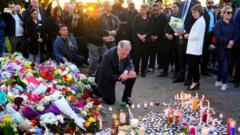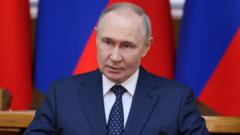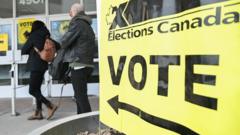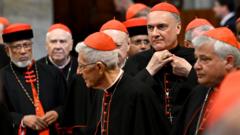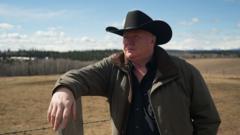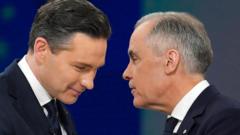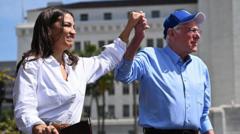With votes being cast across the country for the significant election, Canadians are faced with choosing between Prime Minister Mark Carney's Liberal Party and Pierre Poilievre's Conservative Party. This election is described as pivotal, with President Trump's trade policies creating unexpected alliances and shifting voter sentiments in a race once thought to favor the Conservatives.
Canadians Head to Polls in Crucial Election Marked by Trump’s Influence

Canadians Head to Polls in Crucial Election Marked by Trump’s Influence
Canadians cast their votes amid a highly polarized election environment, influenced by a trade war with the U.S. and a surprising political landscape reshuffle.
April 28, 2025, 12:00 p.m. ET
Canadians are heading to the polls today in a defining election set against the backdrop of President Trump's aggressive trade tactics and a recent shakeup in party leadership. The vote will determine the direction of the country amidst uncertainty and economic pressures resulting from Trump's tariffs.
Current opinion polls show a tight race, with the Liberal Party, led by new Prime Minister Mark Carney, holding a narrow edge over the Conservatives, led by Pierre Poilievre. Just three months ago, the Conservative Party had a commanding lead of over 25 percentage points, but Carney's ascendance has changed the dynamics significantly. The looming economic fallout from Trump's trade policies, including tariffs on Canadian exports, has influenced public perception, making Carney look like a more viable option for voters concerned about foreign relations.
In Canada’s electoral system, voters pick representatives for their local parliaments, with the party garnering the most seats forming the government. Besides the two major parties, the New Democratic Party, the Bloc Québécois, and the Greens are also contesting the election, but none are projected to make significant gains.
Mark Carney, age 60 and a former banker, has positioned himself as a centrist who can provide economic stability and promote strength against Trump’s bullying tactics. His supporters view his experience as essential for navigating the turbulent political climate, while critics accuse him of elitism stemming from his finance background.
Pierre Poilievre, age 45 and a seasoned political figure, has taken a more populist stance. His proposals for deregulation and smaller government resonate with some voters, though his ties in rhetoric with Trump have raised concerns among those wary of U.S. influence on Canadian sovereignty.
Polls are staggered across Canada’s six time zones, with most closing by 9:30 p.m. ET. Ballots are counted by hand, which may delay the results until later in the evening. Carney's recent rise in popularity can be attributed to a prevailing desire for a leader seen as competent to confront Trump's intimidation tactics, contrasting with the Conservatives' prior momentum.
Overall, as Canadians approach the electoral deadline, the implications of this election stretch far beyond the ballot box, presenting a critical opportunity for citizens to articulate their stance on national identity, economic stability, and international relations in a rapidly changing global landscape.
Canadians are heading to the polls today in a defining election set against the backdrop of President Trump's aggressive trade tactics and a recent shakeup in party leadership. The vote will determine the direction of the country amidst uncertainty and economic pressures resulting from Trump's tariffs.
Current opinion polls show a tight race, with the Liberal Party, led by new Prime Minister Mark Carney, holding a narrow edge over the Conservatives, led by Pierre Poilievre. Just three months ago, the Conservative Party had a commanding lead of over 25 percentage points, but Carney's ascendance has changed the dynamics significantly. The looming economic fallout from Trump's trade policies, including tariffs on Canadian exports, has influenced public perception, making Carney look like a more viable option for voters concerned about foreign relations.
In Canada’s electoral system, voters pick representatives for their local parliaments, with the party garnering the most seats forming the government. Besides the two major parties, the New Democratic Party, the Bloc Québécois, and the Greens are also contesting the election, but none are projected to make significant gains.
Mark Carney, age 60 and a former banker, has positioned himself as a centrist who can provide economic stability and promote strength against Trump’s bullying tactics. His supporters view his experience as essential for navigating the turbulent political climate, while critics accuse him of elitism stemming from his finance background.
Pierre Poilievre, age 45 and a seasoned political figure, has taken a more populist stance. His proposals for deregulation and smaller government resonate with some voters, though his ties in rhetoric with Trump have raised concerns among those wary of U.S. influence on Canadian sovereignty.
Polls are staggered across Canada’s six time zones, with most closing by 9:30 p.m. ET. Ballots are counted by hand, which may delay the results until later in the evening. Carney's recent rise in popularity can be attributed to a prevailing desire for a leader seen as competent to confront Trump's intimidation tactics, contrasting with the Conservatives' prior momentum.
Overall, as Canadians approach the electoral deadline, the implications of this election stretch far beyond the ballot box, presenting a critical opportunity for citizens to articulate their stance on national identity, economic stability, and international relations in a rapidly changing global landscape.


